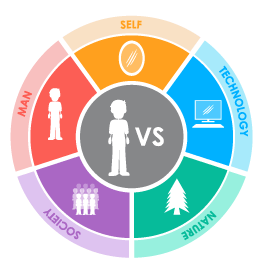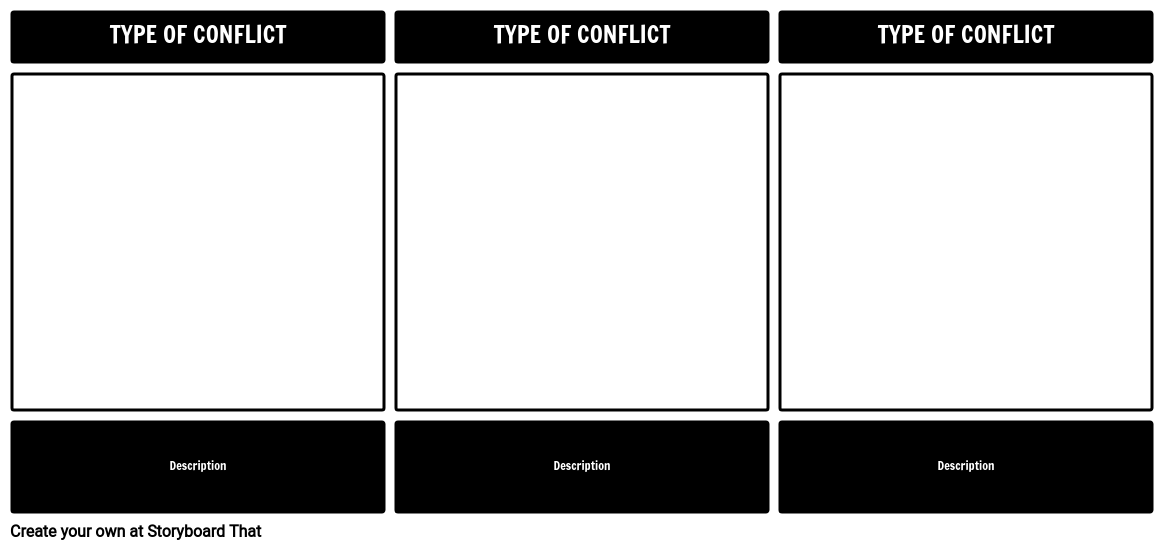Lesson Plan Overview
Literary conflicts are often taught during ELA units. Building on prior knowledge to achieve mastery level with our students is important. An excellent way to focus on the various types of literary conflict is through storyboarding. Having students choose an example of each literary conflict and depict it using the storyboard creator is a great way to reinforce your lesson!
Conflict is a major recurring element in Of Mice and Men. Much of the it stems from Lennie’s disability.
Examples of Literary Conflict in Of Mice and Men
MAN vs. SELF
George struggles with the decision to kill Lennie.
MAN vs. SOCIETY
The stable hand is isolated from the men because he is African American. This displays the prejudice of the period, and the cause of his isolation.
MAN vs. MAN
Curley attacks Lennie. George tells Lennie it is ok to fight back. This leads to Curley’s hand being crushed.
Template and Class Instructions
(These instructions are completely customizable. After clicking "Copy Activity", update the instructions on the Edit Tab of the assignment.)
Student Instructions
Create a storyboard that shows at least three forms of literary conflict in Of Mice and Men.
- Identify conflicts in Of Mice and Men.
- Categorize each conflict as Character vs. Character, Character vs. Self, Character vs. Society, Character vs. Nature, or Character vs. Technology.
- Illustrate conflicts in the cells, using characters from the story.
- Write a short description of the conflict below the cell.
Lesson Plan Reference
Student Rubric
(You can also create your own on Quick Rubric.)
| Proficient | Emerging | Beginning | Try Again | |
|---|---|---|---|---|
| Conflict Identification | Student identifies correct major conflicts and uses strong, clear textual evidence to support choice. | Student identifies correct major conflict and uses few or unclear details to support their choice. | Student identifies incorrect major conflict, and uses some details from the text to support their choice. | Student does not attempt to identify major conflict or identifies incorrect major conflict with no explanation. |
| Understanding Outcome | Student clearly shows the outcome of the conflict and its effects on the protagonist with evidence from the text. | Student shows the outcome of the conflict and its effect on the protagonist, but some evidence is unclear. | Student shows the outcome of the conflict, but does not examine its effect on the protagonist and uses some vague textual evidence. | Student does not clearly show the outcome of the conflict or use textual evidence. |
| Character | Storyboard includes all required characters and clearly names them. Goes above and beyond by adding additional details. | Storyboard includes all required characters and clearly names them. | Storyboard includes protagonist and antagonist but leaves out other required characters. | Storyboard does not include the names of required characters. |
| Storyboard | Student clearly shows effort to convey the setting the scene of the book | Student attempts to convey setting and scene of the book, but lacks some clarity. | Student does not clearly convey the setting and scene. | Student makes little or no attempt to convey the setting or scene. |
| Spelling and Grammar | Student uses exemplary spelling and grammar. There are no errors. | Student makes a minor error in spelling and grammar. | Student makes several minor errors in spelling and grammar. | Student makes many errors in spelling and grammar; little attempt at spellchecking. |
Lesson Plan Overview
Literary conflicts are often taught during ELA units. Building on prior knowledge to achieve mastery level with our students is important. An excellent way to focus on the various types of literary conflict is through storyboarding. Having students choose an example of each literary conflict and depict it using the storyboard creator is a great way to reinforce your lesson!
Conflict is a major recurring element in Of Mice and Men. Much of the it stems from Lennie’s disability.
Examples of Literary Conflict in Of Mice and Men
MAN vs. SELF
George struggles with the decision to kill Lennie.
MAN vs. SOCIETY
The stable hand is isolated from the men because he is African American. This displays the prejudice of the period, and the cause of his isolation.
MAN vs. MAN
Curley attacks Lennie. George tells Lennie it is ok to fight back. This leads to Curley’s hand being crushed.
Template and Class Instructions
(These instructions are completely customizable. After clicking "Copy Activity", update the instructions on the Edit Tab of the assignment.)
Student Instructions
Create a storyboard that shows at least three forms of literary conflict in Of Mice and Men.
- Identify conflicts in Of Mice and Men.
- Categorize each conflict as Character vs. Character, Character vs. Self, Character vs. Society, Character vs. Nature, or Character vs. Technology.
- Illustrate conflicts in the cells, using characters from the story.
- Write a short description of the conflict below the cell.
Lesson Plan Reference
Student Rubric
(You can also create your own on Quick Rubric.)
| Proficient | Emerging | Beginning | Try Again | |
|---|---|---|---|---|
| Conflict Identification | Student identifies correct major conflicts and uses strong, clear textual evidence to support choice. | Student identifies correct major conflict and uses few or unclear details to support their choice. | Student identifies incorrect major conflict, and uses some details from the text to support their choice. | Student does not attempt to identify major conflict or identifies incorrect major conflict with no explanation. |
| Understanding Outcome | Student clearly shows the outcome of the conflict and its effects on the protagonist with evidence from the text. | Student shows the outcome of the conflict and its effect on the protagonist, but some evidence is unclear. | Student shows the outcome of the conflict, but does not examine its effect on the protagonist and uses some vague textual evidence. | Student does not clearly show the outcome of the conflict or use textual evidence. |
| Character | Storyboard includes all required characters and clearly names them. Goes above and beyond by adding additional details. | Storyboard includes all required characters and clearly names them. | Storyboard includes protagonist and antagonist but leaves out other required characters. | Storyboard does not include the names of required characters. |
| Storyboard | Student clearly shows effort to convey the setting the scene of the book | Student attempts to convey setting and scene of the book, but lacks some clarity. | Student does not clearly convey the setting and scene. | Student makes little or no attempt to convey the setting or scene. |
| Spelling and Grammar | Student uses exemplary spelling and grammar. There are no errors. | Student makes a minor error in spelling and grammar. | Student makes several minor errors in spelling and grammar. | Student makes many errors in spelling and grammar; little attempt at spellchecking. |
How To Explore External Conflicts Present in “Of Mice and Men”
Introduce the Concept
Introduce the concept of literary conflicts to students and explain the different types of conflicts that can be found in literature. Help the students differentiate between internal and external conflicts and then their further categories such as character vs character or character vs self. Teachers can also use some simple and relatable examples to clarify the concept.
Talk About Character vs. Society Conflict
Talk about the external challenges that the characters, especially George and Lennie, face with society. Help the students examine the difficulties they face as traveling laborers during the Great Depression and the effects that cultural norms have on their lives.
Discuss Character vs Character Conflict
Students can also examine character conflicts, such as the rivalry between Curley and Lennie or the relationships of power between the ranch workers. Talk about the ways in which these conflicts add to the novel's overall tone.
Compare the Conflicts
Ask the students to contrast the external conflicts in "Of Mice and Men" with those in other literary works or actual circumstances. Their comprehension of conflict dynamics may be expanded by using this comparison method. As an activity, teachers can assign students another story of a similar level and ask them to compare external conflicts in those stories and analyze their significance in the development of the narrative.
Make Conflict Charts
Ask the students to make conflict charts that explore different types of literary conflicts present in the story. Students can divide the chart into 3-4 parts and dedicate the space of each part to a specific type of conflict. Help the students decide what they will be including in these charts such as interesting visuals, symbols, or texts that can explain the conflict in an easier way.
Frequently Asked Questions About Literary Conflict in “Of Mice and Men”
How do the internal conflicts in the story help in the development of the characters?
The development of characters is aided by internal conflicts, such as those arising from characters' struggles with regrets and dreams. For instance, George struggles with striking a balance between his personal aspirations for a better life and his allegiance to Lennie. Geroge also struggles with the decision to kill Lennie and ultimately performs the deed thinking that Lennie will be killed by the hands of other people.
In what ways does Curley and Lennie's conflict develop throughout the book?
Power tensions on the ranch are a larger subject that is reflected in the physical conflict between Curley and Lennie. Due to Lennie's size and perceived vulnerability, Curley, a little man with an explosive temper, targets him, which causes the plot to take a grave turn.
More Storyboard That Activities
Of Mice and Men
Testimonials

“By using the product, they were so excited and they learned so much...”–K-5 Librarian and Instructinal Technology Teacher

“I'm doing a Napoleon timeline and I'm having [students] determine whether or not Napoleon was a good guy or a bad guy or somewhere in between.”–History and Special Ed Teacher

“Students get to be creative with Storyboard That and there's so many visuals for them to pick from... It makes it really accessible for all students in the class.”–Third Grade Teacher
© 2026 - Clever Prototypes, LLC - All rights reserved.
StoryboardThat is a trademark of Clever Prototypes, LLC, and Registered in U.S. Patent and Trademark Office








